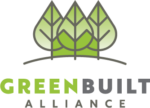Coming Down the Mountain
Garret K. Woodward
Turning onto Audubon Drive in Woodfin, the road winds up the steep hillside, with nearby Interstate 40 fading below, the cityscape of Asheville in the distance. Soon, a residential property appears with a large garden covering the front yard.
The garden, alongside the property itself, is lush, more so than one would believe seeing as Western North Carolina has been experiencing drought-like conditions this year.
“For what we’re trying to do, it’s about taking responsibility for the effects that my presence has on the environment,” said Benjamin Portwood. “It’s taking the rainwater falling on your property and making sure it doesn’t become a problem for someone else, where it now will become an asset to yourself and your property.”
Chief manager and “purveyor of plants” for Edible Yard & Garden Landscapes (an Asheville-based company specializing in edible and ecological landscaping), Portwood strolls the private residential property, one where the front yard is one large slope downward to the street.
“During rain events, where we experience heavy water flow, as with this steep front yard, the water runs off the property, ultimately flooding the street and making the French Broad River rise exponentially,” he said.
Portwood points to a large 1,500-gallon rainwater collection cistern butting up against the residential home. For every inch of rainwater falling on the property, Portwood estimates between 5,000 and 8,000 gallons of water is collected, either through the cistern or by the numerous swales that take the overflow and meticulously distribute the water around the landscape.
“For the rainwater harvesting collection here, we do what I call an ‘active’ process, which is rainwater harvested through the cistern that has a pump-distribution system with an irrigation timer that manages the garden,” he said. “The overflow from the system goes into the earthworks, in this case swales, that are also known as ‘green gardens’ and ‘basins,’ all of which prevents the rainwater from leaving the property.”
Within their low-maintenance edible landscaping and rainwater collection designs, the company installed more than two-dozen species of plants and trees on the Woodfin property — blueberries to pears, apples to chestnuts, mulberries to asparagus. Atop that, they also planted a natural wildflower meadow mix where more than 30 species of the picturesque blooms are showcased for looks and for purpose.
“It’s about sustainable landscaping, and being able to grow all types of food on your own property,” Portwood said. “A lack of water infiltration into the ground is responsible for both droughts and flooding. The water running off the property will cause drought-like conditions because it’s not infiltrating the ground. With the collection systems and edible landscaping, we’re now able to have water stored in the soil, and in the cistern, to be used when drought conditions affect the region.”
Portwood noted that municipalities around the country are already instituting green ordinances focusing on rainwater collection, seeing as droughts are projected to become more frequent and stick around much longer (and storms that do occur to become more aggressive) as we push further into the 21st century.
“Asheville is already on track to someday have these green ordinances,” he said. “And with collecting the stormwater on your own property, you’re not only saving on your water bill and having a fresh source of rainwater, you’re also saving your local municipalities money due to the fact there would be a decreased need for expensive earth and stormwater mitigation projects.”
Just like solar energy, Portwood pointed out that the upfront cost for rainwater collection systems is becoming more and more of an affordable option for homeowners and commercial businesses. That upfront cost will lead to long-term savings, and with that, the technologies and initiatives themselves can be tailor-made to each customer.
“There are expensive and inexpensive options,” Portwood said. “It’s about what your needs are, what your budget is, and what you ultimately want out of your system — it’s making what was once a nuisance into an asset for your home.”
You can also view this article as it was originally published on page 20 of the 2016-2017 edition of the directory or as a pdf.

